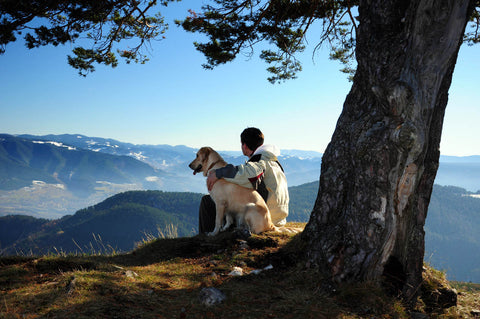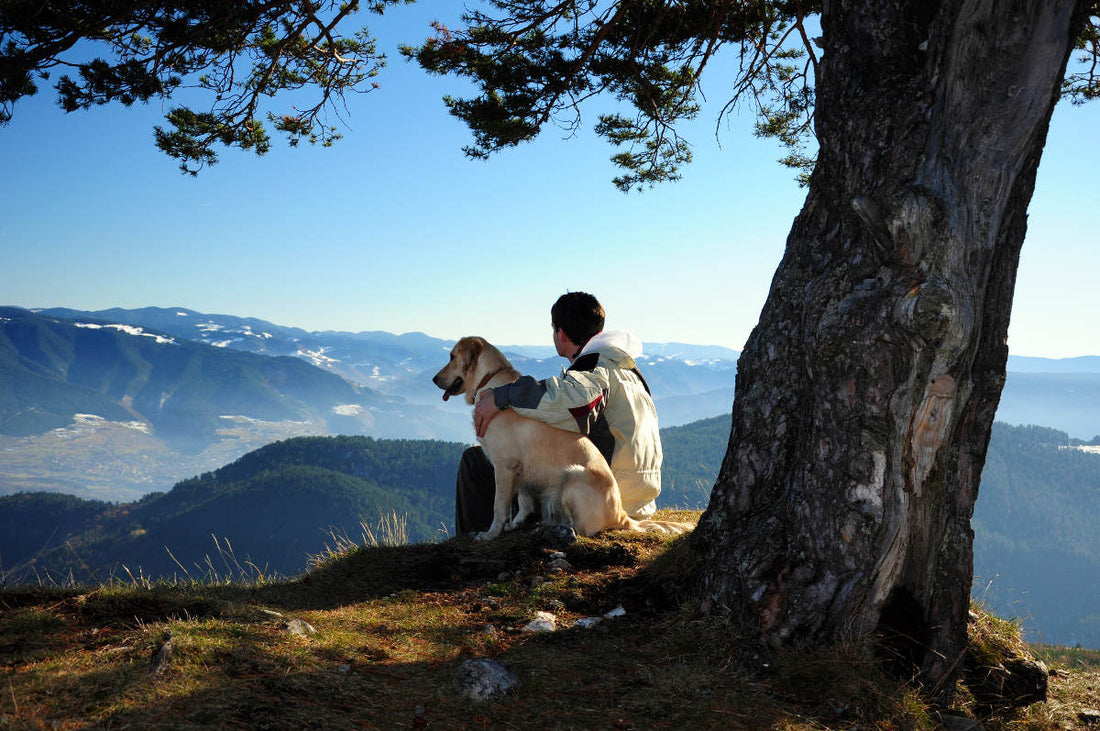
As summer winds to a close and the weather begins to cool, it’s the perfect time to think about hiking with your dog. Peak hiking season is just around the corner, and for a lot of pet owners, their favorite hiking trails wouldn’t be the same without their four-legged friends!
Whether you and your dog are experienced hikers or only just getting into the swing of things, the fall season is a great time to hit the trails and stretch your legs a little bit. Before you go, make sure you’ve done the research, and have the dog treats you need, to make your hiking trip a blast for you and your dog alike!
Safety Tips for Hiking With Your Dog
The first thing to consider when you’re setting off on a brand new trail is the safety of your pet. Not every dog is meant for the great outdoors, and if your dog has any pre-existing health conditions that may prevent them from being able to enjoy a hard day’s hiking, then you may want to start them out on a gentler trail.
- Old dogs, in particular, will need to be walked on a gentler trail than young dogs, as their health most likely won’t allow them to blaze the same trails they used to love.
- The breed of your dog plays a major role in their outdoor suitability and fitness. Brachycephalic breeds like Pugs, Boxers, and Bulldogs have shorter airways and are not physically capable of taking long, hot, or fast-paced walks.
- Breeds with a high prey drive (Greyhounds, Airedales, and Irish Wolfhounds, for example) are prone to distraction on busy hiking trails, and may try to run after wildlife, which could potentially threaten the safety of you and your dog alike.
- Consider the nature of the trail you plan to hike. Rocky paths will be a major pain for your dog’s paws, and trails that are too exposed pose a higher risk of heat damage to the pads of their feet.
- Most dog-friendly hiking trails require that your dog be on leash at all times, but for the ones that don’t, check beforehand to make sure that there are no issues with the trail that could cause problems for you and your dog. Keep an eye out for things like rivers and creeks, steep trails or cliffs, or dangerous wildlife.
- Similar to the above, wildlife encounters can be just as dangerous for you as they are for your dog. If you live in a desert area, make sure you’re ready to deal with snakes or other venomous creatures. Wooded areas may have snakes as well, but also run a higher risk of larger creatures like bears or wild cats.
Dog Fitness Is Important
This may seem like a continuation of the previous entry, but it’s important enough to merit its own consideration. Beyond factors of breed and age, there are a lot of other important aspects of your dog’s health to consider before hitting the trails. This includes aspects like:
- Vaccines: most puppies have already had their vaccines by the time they’re ready to start thinking about hiking, but you may want to look into specific vaccines, depending on the terrain of the trail.Other potential diseases that may need preventative medicine include giardia and Leptospirosis. These diseases are a particular concern if your dog has a habit of drinking out of lake, river, or puddle water, which runs a high risk of being infected.Check with your vet before you tackle a new trail, and be ready to deal with any individual illnesses as they arise.
- Development: if your puppy is younger than eight months, he or she should not be on strenuous hikes. Eight months is the absolute minimum age that dogs should be started on tough trails or fast-paced hikes.If your dog is just at or around eight months old, try starting them out on easy trails, and take your time! Enjoy the scenery and hold off on super-intense trails until your dog is a little bit older.
- Physical Fitness: again, it’s okay to start on easier trails and work your way up. Just like humans, dogs can be at all different levels of fitness, depending on their history and lifestyle.You wouldn’t expect someone to go from sitting on the couch to running a marathon in a day, and it’s not fair to ask the same of a dog. If you’re trying to get your dog into shape, it’s generally advised to start with an easy trail before you tackle that tough mountain trail.

Understand Dog Laws and Regulations
As mentioned earlier, it’s important that you take the time to research the rules surrounding your preferred hiking destination before you pack up your dog and head for the hills. Most public spaces are dog-friendly nowadays, but it still doesn’t hurt to double-check before you hit the trails.
- It should go without saying, but if a hiking trail doesn’t allow dogs, don’t bring your dog! Rules prohibiting dogs are generally in place for a reason, and the last thing you want is for you and your dog to come face to face with an angry herd of elk or a curious rattlesnake without warning.Usually, if a public hiking trail doesn’t allow animals, it’s because there’s some threat to animals, whether it be in the shape of a treacherous terrain or other animals. While it can be a bummer to have to remake your plans, it’s still better to follow the posted signs and pick another hiking spot!
- If the hiking trail allows dogs on leash, then you’re probably good to go! Pack your bags and head for the nearest trail! Generally, be prepared to yield to pet-less pedestrians, as wells as cyclists or horseback riders.As long as you can maintain control over your dog when faced with other hikers (small children, other pets, or even just overenthusiastic dog lovers), keeping your dog on a leash can still be a great way to give them the exercise they need!
- Most trails do require leashes for all pets, but if you’re lucky enough to live near a trail that doesn’t require a leash, make sure you’re still able to control your dog.If you’re satisfied in your dog’s ability to respond to voice commands, then there shouldn’t be anything stopping you from taking the road less traveled to the end of the trail!
Don’t Forget Food and Water
Whenever you head out on a hike, make sure you remember to pack enough treats for both you and your dog! While it may take up a little more room in your backpack or hiking bag, packing supplies for you and your four-legged friend can go a long way toward making sure that the two of you have a better time out on the trails.
- Water: dogs can’t sweat the way humans can, which means the only way that they can thermoregulate is by panting. Obviously, this can dry them out pretty quickly, so it’s important that you have enough water to keep them going all day long.At the very minimum, your dog will need about one ounce of water per pound of body weight. This is the normal amount of water that they should be drinking during the day, but it can quickly increase when they’re working out.Fortunately, there are a lot of great products available on the market today that will let you give your dog a cool drink of water without taking up too much space in your backpack!
- Food: you don’t need to have a full three-course meal ready for your dog on the trail, but having a few little snacks for them can help them keep on their feet when the trail gets a little long.In general, try to avoid treats that are high in salt or sodium by-products.While your dog may love these tasty little snacks, they’re also probably going to get more dehydrated more quickly than they would after having some healthier options.Look for natural products that will boost your dog’s energy without hurting them too badly in a long run. In particular, foods that are high in protein and natural sugars are usually a healthy dog treat!

Last Tips
The previous entries cover the main considerations before you hit the trails, but there are still a few more items to keep in mind. Before you head out the door and into the great unknown, try to remember:
- Don’t cut corners on clean-up: cleaning up your dog’s messes is an unpleasant reality of hiking with your dog. Beyond just simple good manners, it also reduces the risk for other dogs of picking up nasty illnesses like giardia, and makes it less likely that your favorite trail will put up a “no dogs allowed” sign anytime soon!
- Think about a doggy bag: if you’re worried about juggling all these extra supplies (and if your dog is big enough), you may want to consider letting them carry their own backpack. Don’t load it down too much, but as long as it’s relatively light, your dog should be happy to pull his own weight, literally!
- Don’t forget first aid: this can be lumped into the aforementioned doggy bag, but make sure you’ve got supplies on hand in case you run into any unpleasant surprises. Simple disinfectants, bandages, and scissors can go a long way towards fixing any injuries you or your dog may incur on your hike. Tick supplies, too, will save you a lot of time and stress in the future!
- Clothes make the man (and sometimes the dog: while your dog may not love wearing a few extra layers, a jacket can help protect them against water or sudden weather changes, and an LED leash can make sure that they’re easy to spot no matter the time.
No matter where your trails lead you this fall, it’s always best to have your best friend by your side. As long as you take the time to do a little bit of extra research, you and your dog should be exploring the great outdoors with confidence and ease, ready to take on one adventure after another!
Make sure you consider your dog’s health, safety, and well-being before you head out, and once that’s taken care of, you shouldn’t have any problem following the road less traveled, wherever it ends up taking you!

